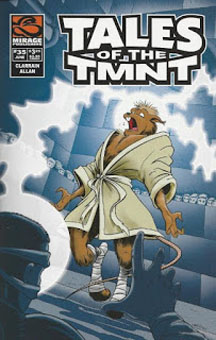Part of the purpose of “Tales of the TMNT” Volume 2 was to go back and fill in all those little story gaps that cropped up in 20-plus years of dozens of writers contributing odds and ends to the “TMNT” mythology. If there was a theme to the issues of 2007, when Steve Murphy handed off editorial duties to Dan Berger, it was going back to the source material and filling in key story elements. Mostly, this led to an enrichment of the grand story, but …
Reimagining the Rat King
Issue 35 (“The Pantheon”), by Dean Clarrain and Chris Allan, might be the most incomprehensible piece of “TMNT” fiction out there. In the letters pages of early “Tales” issues, many readers asked for Rat King tales only to be told “Sorry, no plans for Rat King stories at the moment.”
Issue 35 changed that in a big way by telling his origin story. To a certain extent, I agree with Mark Pellegrini at TMNT Entity that some characters are best left mysterious, and the bandage-shrouded Rat King is one of those.

“Tales of the TMNT” Volume 2 Issues 31-41 (2007)
Writers: Quinn Johnson, Peter Laird, Ryan Brown, Stephen Murphy, Mike Manley, Bill Moulage, Dan Berger, Chris Allan, Tristan Huw Jones, Jake Black, Dario Brizuela, Diego Jourdan, Martin Casanova, Steph Dumais
Pencils: Andres Ponce, Dario Brizuela, Mike Manley, Jim Lawson, Chris Allan, Paul Harmon, Diego Jourdan, Andie Tong, Steph Dumais
Inks: Sean Parsons, Rich Faber, Joe Rubinstein, Mike Manley, Jim Lawson, Chris Allan, Paul Harmon, Diego Jourdan, Dario Brizuela, Dan Berger, Steph Dumais
Still, I’d be OK with a really good Rat King origin story. Instead, we learn that there was a supernatural Rat King who existed before this one, and that’s the worst kind of comic-book-character origin story: One where their origin comes from newly invented supernatural characters whose origins we don’t know either.
Since this old Rat King is dying, his fellow supernatural superhero team members in The Pantheon recruit Splinter to take over the post. Splinter politely declines, and The Pantheon reluctantly chooses the guy we met in “Tales” Volume 1, Issue 4, as the Rat King.
Even though it seemed in that issue that he invented himself as the Rat King spontaneously. “The Pantheon” is a “Huh? OK, whatever” story if there ever was one, although I guess it explains why the Rat King was able to continue on as a ghost.
A Casey fake-out
Speaking of origin stories, Issue 37 (“Casey in Point”), by Jake Black and Peter Laird, promises a Casey Jones origin story, but it turns out to be a clever fake-out. Casey tells a fellow bar-goer a detailed, emotional tale about how his brother, Davy, was murdered by street thugs, thus inspiring Casey to be that rare street tough who is on the side of good even as he has been tragically estranged from his parents.

After Casey leaves, the bartender tells the listener that Casey was yankin’ his chain all night.
To me, this was both a relief – as an origin story, Casey’s tale was too generic, and also contradictory because we know Casey is not estranged from his mom, who we meet in “City at War” – and it lifted this tale from OK to pretty great because it reaffirmed Casey’s mysterious past.
While there wasn’t a big event that led him to voluntarily beating the crap out of bad guys, his collective experiences of growing up in the crime-rotted 1980s Big Apple led him in that direction. The fact that he’s not inspired by a big tragedy in his life makes him an everyday hero even more worth rooting for.
By comparison, would Batman have done so much crime-fighting if his parents hadn’t been killed? If the answer is no, then that makes him more selfish than someone like Casey.
Issue 31 (“Reflections” by Quinn Johnson) is another strong Casey issue that resolves somewhat of an emotional cliffhanger. He was haunted off and on by a nightmare alter-ego in “City at War” and Volume 2 (literally) and Volume 3 (figuratively). Here, in a tale set in Volume 4, he defeats his monstrous dark half, which is given form by an alien shapeshifter with mimicry talent.
Oldsters
Issue 41 (“Swan Song”), by Murphy and Steph Dumais, finds a 129-year-old Leonardo remembering the entirety of his love story with Radical. While this was new to “Tales” readers in 2007, it served as a “filling in the gaps” story for me because I had already read the special Volume 3, Issue 25 (2012) – where Leo tells Raph he has a secret relationship with Radical – as part of this “TMNT” flashback project.
“Swan Song” also marks the moment when Future Leo vows to never kill again after dispatching Radical’s murderer, Complete Carnage. (“Carnage was my final kill. My final need for cleansing.”)
Interestingly, while I’ve often disagreed with Leo for being hypocritical about violence (see “Tales” Volume 2, Issue 6, when he gives Cha Ocho a facial scar as punishment for a revenge killing, something Leo himself has done more than once), I actually think he’s being too hard on himself for this kill that sent him on a new path toward peaceful enlightenment: Carnage (who is basically pure evil for the sake of evil) absolutely had it coming.
While “Swan Song” is bittersweet, Murphy’s Issue 40 (“Silent Night”) is more in tune with the typically dark Future Turtle stories. Here, an eyepatch-sporting and katana-wielding (!) Raph finds an abandoned baby in Tokyo in 2060. The tale proceeds wordlessly, with Raph presumably trying to find an orphanage or other safe place to deposit the baby.
He fights off loads off Foot Soldiers (while holding the baby!), but they eventually get the best of him and take the child, who it turns out is Karai’s great-granddaughter. “I guess … I miss those good old days,” a withered Karai tells Raph, explaining why she used violence to get back the child, rather than simply asking for it back.
I’m not sure if a reader is supposed to assume that Karai left the baby with Raph on purpose in order to orchestrate the string of violence.
Youngsters
A baby – Shadow, in this case — is also the plot device of Issue 33 (“The Bait”), by Bill Moulage. Like in Image’s Volume 3, Shadow is kidnapped, but whereas that kidnapping led to an excellent arc, this one is just an excuse for the good guys (in this case, Splinter and Casey) to fight Worm-Shark-Shredder (from “Tales” Volume 2, Issues 3-4) … one … last … time. For me, that’s about three times too many, and this is one “story gap” that didn’t need to be filled in.
Sticking with the youngsters theme, the pre-teen Turtles get up to mischief in the sewers in Murphy’s Issue 38 (“Triptyche”), which is one of the five earliest “TMNT” stories chronologically, according to Pellegrini’s timeline at TMNT Entity.
This is nothing more than a fun goof of a story highlighted by Kiddie Raph pissing off Leatherhead by throwing rocks at him. It seems an enraged Leatherhead would’ve killed the young Turtles then and there if some alien rivals of the Utroms hadn’t gotten in the way. (Leatherhead conveniently never notices the Turtles and kills all of the aliens.)
Old friends, and enemies
Berger’s Issue 39 (“What Wolves Wear”) catches us up with another old friend – or rather, enemy, in this case: The sorcerer from “Tales” Volume 1, Issue 3, who tried to bring about Armageddon using a magic statue from April’s shop. In this Halloween sequel, this poor man’s Ethan Rayne again steals the statue (which had been in Don’s lab, awaiting further study), and Raph foils him again.
The twist here is that Raph goes to an alternate vampire- and werewolf-dominated reality to do so, and learns that Leo and Don are dead and Mike’s a werewolf. Yikes. While regular-Future Turtles yarns tend to be grim, at least the Turtles are alive in them.
My favorite comic from this batch (among the issues I own) is Berger’s Issue 34 (“Splinter Cell”), partly because the Jim Lawson art makes it feel like classic TMNT, and partly because we meet a character we never knew we were missing: Hamato Yoshi’s niece, Hana Yoshi. I love the twists in this tale.
At first, it seems she’s just a Foot initiate who is tasked with cutting off the tails of each Turtles’ bandana (by comparison, Keno having to remove the bells from the manikin without making a sound seems a cinch).
Then we learn that Splinter had been secretly training this batch of pseudo-Foot soldiers as a test for both Hana and the Turtles – only to be disappointed by Hana when she rejects his offer to teach her and kills all of the other members of the gang, saying that they (like herself) are not worthy of Splinter’s teachings.
It’s an intriguingly grim twist, and I would’ve loved more stories of Hana Yoshi using her lethal ninja skills to go Casey-Jones-times-10 on some of the New York villains whom Casey and the Turtles would be content to string upside-down from a fire escape.
Speaking of the too-enigmatic (in Mirage stories) Foot Clan, they get some overdue exploration in Issue 36 (“To Serve and Protect,” the first of the “Gang Wars” stories), which gets raves in the “Tales” letters pages. Alas, I don’t have the issue in my collection yet, so it’ll have to be a tale for another day.

